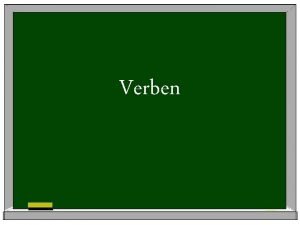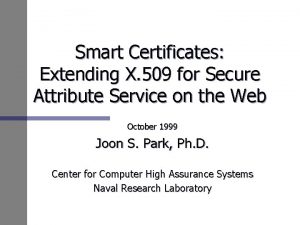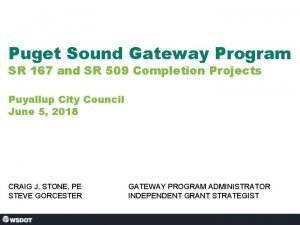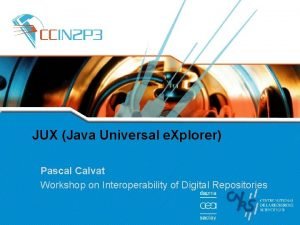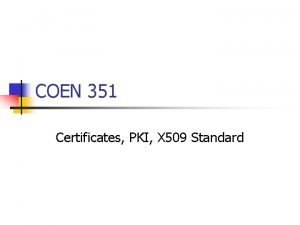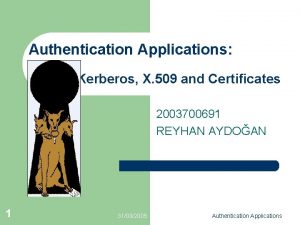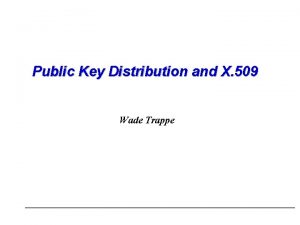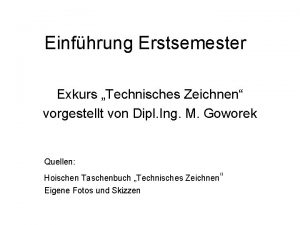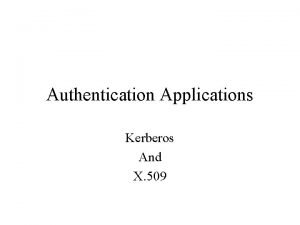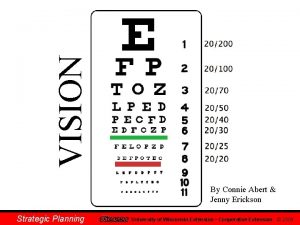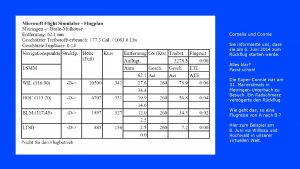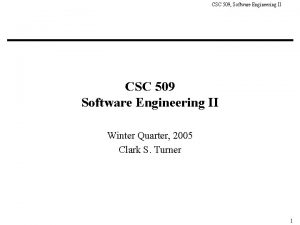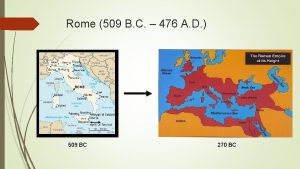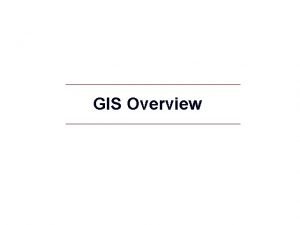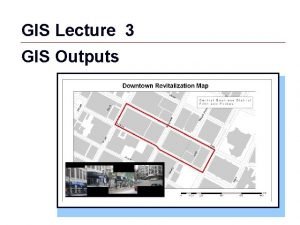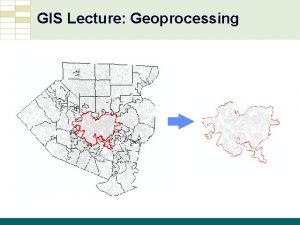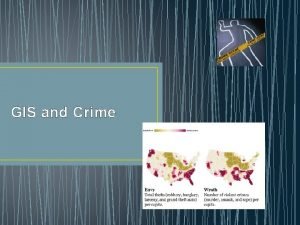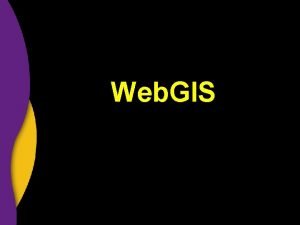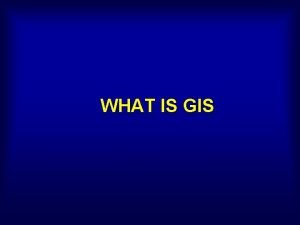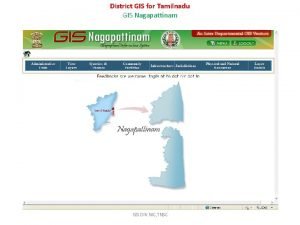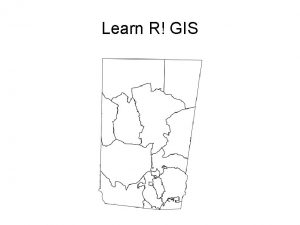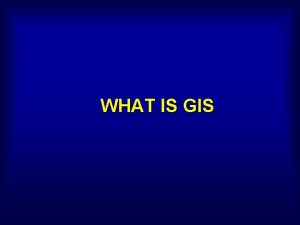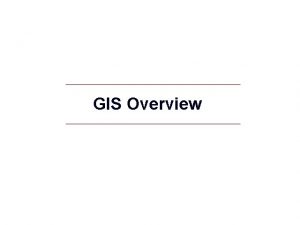SIE 509 Principles of GIS Connie Holden Office


































- Slides: 34

SIE 509 – Principles of GIS Connie Holden Office: Rm 134 Boardman Phone: 581 -3952 262 -7894 Email: cholden@maine. edu Lecture 1 1

Lecture 1 Course Introduction and Introduction to GIS Lecture 1 2

Text GIS Fundamentals (5 th Ed. ) Paul Bolstad Xan. Edu 530 Great Road Acton, MA 01720 800 -562 -2147 2016 ISBN: 978 -1 -50669 -587 -7 Lecture 1 3

Software • Arc. GIS 10. 5. 1 • Access cods for student licenses will be provided. • Runs only on a Windows operating system (8. 1 or higher or 7 Enterprise Edition). • Some departments have older versions. • Three computers in Lab 138 – Karen Kidder for key code. – Log on with Mainestreet id and pw Lecture 1 4

COURSE OBJECTIVES: • This is an introductory course designed to provide the student with: – An overview of the development and basic principles of geographic information systems. – Practical experience in the use of Arc. GIS 10. x (one of the most popular commercial GIS packages). – The implementation of a GIS project using available data. Lecture 1 5

Online Course Materials • Course Materials: http: //umaine. edu/computingcoursesonline • Live Broadcast: Available at http: //meet. maine. edu/sie 509/ • Online students may view and participate in the live sessions but are not required to do so. • Archived Broadcasts: Links to the class broadcasts are made available at the end of each day through the Lectures link for this course. Lecture 1 6

Topics • Introduction to GIS • Dealing with spatial data • Geodesy, Datums, Map Projections and Coordinates • Database management • Data Input, Editing and Output • Spatial Data Analysis • Data Standards and Data Quality • GIS Project Development Lecture 1 7

Assignments • Labs – Eight to 10 lab exercises. – Lab exercises have differing point values (25 -50 Points), depending upon the length and difficulty of the exercise. • Project – The project should be implemented using GIS software. – The project can be related to your research, or be on another topic of interest. Lecture 1 8

Project Examples • Small Scale Variation of Atlantic Cod in Inshore Gulf of Maine • Analysis of Maine Moose & Automobile Crashes • A Geographic Analysis of Drug Abuse Offenses in Northern New England • A Geographic Analysis of Applications for Admission to UM • Creation of a map and database of the Orono bike trails • Changes in UM green space over time Lecture 1 9

• Access to Facilities among Bangor’s Low Income Population • Mapping China’s Long March • An Analysis of Campus Crime and the Placement of Blue Lights. • Mapping the Fay Hyland Botanical Garden • The Joys and Sorrows of Geocoding • Landslides along the Maine Coast • Glacial geology in Miers Valley, Antarctica • ATM Locations in Bangor Lecture 1 10

Citation Analysis Flooding potential along various coast lines. Monitoring Age Change in Downeast Maine Measuring the Impact of Pollution Closures on the Harvesting of the Soft-Shell Clam • The Modernization of Agriculture in Nineteenth Century Maine • Direction Relations using Arc. GIS • Growing Grapes in Northern Portugal • • Lecture 1 11

Project Dates • • • Proposal – Sept. 21 List of data files and their source – Oct. 12 Data dictionary – Nov. 9 Oral presentations begin – Dec. 4 Final report and CD with project – Dec. 15 Lecture 1 12

Exams • There are two exams scheduled: – Exam 1 - Oct. 17 th – Exam 2 – Nov. 30 th Grading • Lab exercises 25% • Exams (2) 25% each • Project 25% • Plus and minus grading will be used. Lecture 1 13

An Introduction to GIS Chapter 1 Lecture 1 14

What does GIS stand for? • Geographic (Geography) • Information • System Lecture 1 15

What is a Geographic Information System? • Geographic Information System (GIS) – A computerbased system for the collection, storage, organization, maintenance, and analysis of spatiallyreferenced data, and the output of spatiallyreferenced information. – – • Data – Any collection of related facts; the basic elements of information. Information - Data that have been processed to be useful; provides answers to "who", "what", "where", and "when" questions Information can only come from accurate data (GIGO). Lecture 1 16

What are the components of a GIS? We understand GIS to be computer facilitated system But it is NOT only software and hardware Also includes: • Data – both spatial and aspatial • Trained personnel • Supporting Institution • Protocols for use Lecture 1 17

GIS Software Tools (the frustrating part) GIS started at universities as research tools – Harvard, Yale, Minnesota, Clark University GIS software have evolved to robust (sort of) tools capable of a wide variety of tasks Primary flavors ESRI (Arc. GIS) Intergraph Microimages ERDAS GRASS QGIS Autocad Idrisi Geo. Media Bentley Map. Info Manifold AUTOCAD MAP 3 D Lecture 1 Smallworld Maptitude 18

The Map Lecture 1 http: //reliefweb. int/map/syrian-arab-republic/syrian-refugees-region-20 -january-2014 19

The Database

Other Features Graphs Malarial Deaths per 10, 000 People Lecture 1 http: //www. rollbackmalaria. org/microsites/gmap/3 -2. html 21

Other Features Tables https: //desktop. arcgis. com/en/arcmap/10. 3/manage-data/tables/GUID-5 A 309 AD 2 -B 84 E 4 ECF-A 475 -7 E 4 B 492660 EC-web. png Lecture 1 22

Other Features Reports http: //desktop. arcgis. com/en/arcmap/10. 3/guide-books/extensions/business-analyst/GUID-389 C 0 E 819313 -4 C 5 C-94 B 0 -51 D 7650 E 3 B 53 -web. png 23 Lecture 1

The Power of GIS • The interaction between the database and the map, along with the ability to create graphs, tables and reports.

How does a GIS answer spatial questions? GIS allows us to abstract information from the physical world and display it in layers or themes. It allows us to: • Input and edit both spatial and attribute data. • Display data on a screen or print a map. • Analyze the data for making decisions and searching for patterns. • Create models and ask “what if”. Lecture 1 25

What types of questions can be answered by a GIS? • Where are particular features found? • What geographic patterns exist? • Where have changes occurred over a specified time period? • Where do certain conditions apply? • What will be the implications if an organization takes a certain action? Lecture 1 26

What types of data are used in a GIS? • • Coordinate data Connection information Descriptive information Temporal information Images Documents URL’s Lecture 1 27

Coordinate Data for a GIS • Spatial data – you can attach coordinate information. • 2 D maps (X, Y) Lecture 1 http: //www. mappery. com/map-of/Hong-Kong-Hotel-Map-2 28

3 D –Maps (X, Y, Z) Lecture 1 https: //www. flickr. com/photos/seeminglee/4112874847 29

How is spatial data represented in a GIS? Vectors Raster • Grids/Tesselations • Points, Lines & Areas/Polygons Lecture 1 30

Applications of GIS • Urban Planning, Management & Policy • Zoning, subdivision planning Civil Engineering/Utility Locating underground facilities Designing alignment for freeways, transit Coordination of infrastructure maintenance • Land acquisition • Economic development • Code enforcement • Housing renovation programs • Emergency response • Crime analysis • Tax assessment • Environmental Sciences Business Demographic Analysis Market Penetration/ Share Analysis Site Selection • Monitoring environmental risk • Modeling storm water runoff • Management of watersheds, floodplains, wetlands, forests, aquifers • Environmental Impact Analysis • Hazardous or toxic facility siting • Groundwater modeling and contamination tracking • Political Science • Redistricting • Analysis of election results • Predictive modeling Education Administration Attendance Area Maintenance Enrollment Projections School Bus Routing Real Estate Neighborhood land prices Traffic Impact Analysis Determination of Highest and Best Use Health Care Epidemiology Needs Analysis Lecture 1 Service Inventory 31

GIS Before Computers Cholera Map of Dr. John Snow (UK 1850 s) Lecture 1 32

There’s Another GIS/GISc • Geographic Information Science – comprehending the underlying conceptual issues of representing data and processes in space-time – the science (or theory and concepts) behind the technology • GI Science is the focus of the research in this department. Lecture 1 33

Assignment – Chapter 1 of Text Lecture 1 34
 Connie holden
Connie holden Verben ich du er sie es wir ihr sie
Verben ich du er sie es wir ihr sie Ich du sie er sie es
Ich du sie er sie es Ihnen dativ
Ihnen dativ Prsens
Prsens 1 person 2 person 3 person
1 person 2 person 3 person Redemittel zum telefonieren
Redemittel zum telefonieren Ich bin du bist er sie es ist wir sind ihr seid sie sind
Ich bin du bist er sie es ist wir sind ihr seid sie sind Sr 509 extension
Sr 509 extension X.509 attributes
X.509 attributes 753-509
753-509 Puget sound gateway project
Puget sound gateway project Sr 509 extension
Sr 509 extension 509 sports
509 sports Jux jav
Jux jav X.500 certificate
X.500 certificate Kerberos x.509
Kerberos x.509 Kerberos
Kerberos X.509
X.509 Republica romana 509 a 27 a.c
Republica romana 509 a 27 a.c X.509
X.509 Din 509
Din 509 Donkey protocol
Donkey protocol Kerberos x.509
Kerberos x.509 753-509 a.c
753-509 a.c 509
509 Trimuvirate
Trimuvirate X 509
X 509 Entertainment in rome
Entertainment in rome Roma 509
Roma 509 Itu x.509
Itu x.509 X.509 vs pgp
X.509 vs pgp Kerberos x.509
Kerberos x.509 Connie abert
Connie abert Connie sargent
Connie sargent

